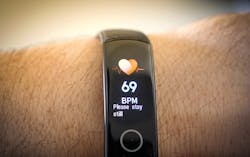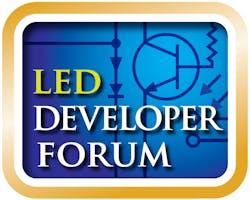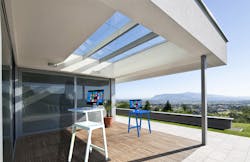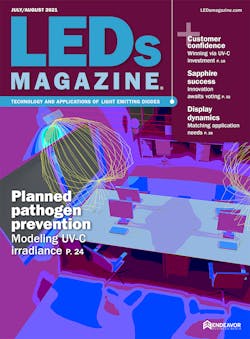If you’re looking at a computer monitor, tablet, or car dashboard today, chances are you will see a backlit liquid-crystal display (LCD). And when it’s time to choose a display to include in your next product design, the most familiar option may seem like the best choice.
There is a huge market for backlit LCDs today, but as mini and micro LEDs and organic LEDs (OLEDs) gain prominence in the latest versions of television screens and backlights in Apple’s new generation of tablets, it’s important to get familiar with the range of display types and display lighting available.
To help product developers get started, we’ll break down the basics of these common lighting types and where the display types are a great fit within product design.
Liquid-crystal displays are a type of transmissive display that uses an LED-powered backlight to send light through diffusers, filters, and a liquid-crystal layer of pixels to illuminate the screen. From consumer products to industrial and medical applications, LCDs are pretty much used everywhere. This display type has a grip on about 80% of the market, and high-end LCDs are competitive with OLED displays.
But LCDs are not without their downsides. Because they are backlit by a panel of LEDs (either a mini LED array or a lightguide edge-lit with LEDs), LCDs don’t perform well outdoors or in bright sunlight due to a lack of contrast to the bright emitters. Consider the last time you tried to read your smartphone or tablet on a sunny day; the display simply isn’t viewable.
These displays also require a high energy budget, which means that they’re a bad fit for mobile devices as they quickly drain battery power, especially in bright environments where the backlight has to be at full brightness to compete with sunlight.
Micro LEDs: Indistinguishable to the human eye
Micro LED displays are well named. These emissive displays are distinct from LCDs in that each pixel emits light directly rather than going through a series of layers and filters. Micro LED displays use microscopic LEDs to create pixels that form images on the screen, and they have been an incredibly popular discussion topic in the first half of 2021.
But there are some misconceptions about this lighting technology. Is the display using mini LED or micro LED technology? Are the pixels of the display made up of these tiny LEDs (i.e., an emissive display), or does the design simply use a standard LCD backlit by an array of mini LEDs (i.e., a transmissive display)? (Refer to an LEDs Magazine feature on mini and micro LED displays for more details on the characteristics, advantages, and challenges of these devices.)
Apple’s newly announced run of iPads highlight the use of mini-LED lighting technology. If we read further into the company’s announcement, we will find that the new iPad Pro actually features a high-definition LCD using mini LEDs as a backlight. Either way, it's likely we’ll see more of these types of tiny LED-powered displays in mobile devices in the years ahead.
In addition to providing excellent resolution and image quality, mini and micro LEDs can be implemented on billboards, indoor displays, and bus stations. For these larger use cases, you can’t tell how far apart the pixels are, which provides a better viewing experience with fewer LEDs. But it also has the potential to be very expensive because volume manufacturing solutions have yet to become standard.
OLED: A solution that’s not designed to last
Like micro LED displays, OLEDs offer a type of emissive display but one that uses organic compounds to emit light when a charge is applied to them.
The primary challenge with OLED displays is right there in the name. They rely on organic compounds to emit light — and organic compounds break down. The quality of these displays is excellent for their first two years of use. They make for beautiful television screens and the picture quality has made this technology a popular choice in smartphone design as well, thanks to the superior contrast ratio. Given how much video content consumers view on smartphones today, it’s no surprise that this display is currently winning in the mobile market.
The other major benefit of OLEDs is that they’re flexible. This technology can curve over the edge of the phone, carrying the viewable screen all the way to the edge of a device — something LCD currently struggles with.
The important thing to remember is that the product use case for OLED-based displays is only about 19–24 months. If you’re designing a device intended to last 4–5 years, the consumers will experience significant degradation in their viewing experience.
The benefits of RLCD: Beyond IoT
Reflective LCDs (RLCDs) consume less power than any display type we’ve covered so far, and their design is relatively simple. They reflect ambient light to illuminate the display.
This is the screen of choice on many outdoor Internet of Things (IoT) devices because it requires so little power to function and continues to increase in brightness as the ambient light gets brighter — an advantage in sunny outdoor environments. However, the downside is that RLCDs are difficult to view in low light conditions, given their design requires ambient light. For a coffee machine, refrigerator, or connected thermostat, this display is an excellent choice when the end user can turn on the lights.
For connected devices, if you choose to specify an RLCD that also has memory-in-pixel (MIP) technology, you can unlock even more functionality because the pixels can retain information about recent images to reduce power consumption. Look for opportunities to use this display in e-book readers, industrial devices, tablets, wearables, and medical devices.
No longer only relegated to household devices and workout equipment, today’s RLCD can be a great display choice for designs with plenty of ambient light, indoors and outdoors.
e-Paper: Not just for e-readers
Formally known as electrophoretic display (EPD) technology, e-paper delivers beautiful black-and-white high-resolution content. Unlike the other displays listed so far, EPD relies on an electric current to rearrange particles under the display’s surface to create images, text, and shapes.
While many readers may have first encountered EPD when they got their first Kindle, today’s e-paper is an excellent choice for barcodes and shelf labels, which is an increasingly popular application in retail outlets, especially in Europe.
Because e-paper displays only refresh once or twice a minute, they require little power. This makes them an excellent choice for e-books and transportation signage. Their color performance is also showing improvement.
Display signage is a competitive space in which many options work, so e-paper should not be overlooked, as this technology provides clear visibility in bright light and requires very little power. There are limitations for video and color requirements, but for black-and-white use, this is an excellent display option.
LCD 2.0: A frontlit option for indoors and outdoors
A combination of an RLCD with an ultrathin front light panel — LCD 2.0 — is a relatively new player in the display market. Because it relies on a small number of LEDs embedded in the edges of a transparent lightguide, LCD 2.0 requires very little power and is readable in both sunlight and low light environments.
Today, LCD 2.0 is in use in industrial and medical products that require long-lasting batteries for mobile use, but it’s also a great fit for tablets, wearables, and automotive displays because it leverages the full video and color capabilities of traditional LCD.
Like many other types of displays on this list, LCD 2.0 panels can also be used to illuminate billboard and larger-scale signage. The differentiator is that LCD 2.0 can both leverage ambient light during daylight hours and emit light from its front light for nighttime visibility, all while maintaining low power consumption.
A word on transflective displays
Any conversation about the types of displays available today would be incomplete without a mention of transflective displays. This combination of reflective and transmissive displays is an option, but it’s not one I’d recommend. This amalgamation doesn’t perform reflective or transmissive functions well enough to be a competitive option in today’s market. It is the worst of both worlds.
What's right for your project?
As you design your next product, you may find yourself looking at the displays you and your customers are most familiar with. Perhaps your marketing team will advocate for using the latest and greatest in display technology, or maybe you’ll be tasked with identifying the right display to fit within the device and your budget. What matters most is that the display must be reliable. It must meet the product’s functional requirements and customer expectations.
To help you begin to narrow down your options, answer the following questions:
- What are the required dimensions of this display?
- Is weight a factor?
- What are the resolution requirements?
- How much of your energy budget do you have to allocate to the screen?
- Does energy efficiency matter for marketing or performance reasons?
- Do you need a full-color display, black-and-white, or something in between?
- Does it need to be viewable in bright light?
- Does it need to be readable in low light?
- Are blue light emissions a concern?
- What is your budget for this component?
Of course, there will be more questions that follow from the engineering team regarding the electronic performance characteristics such as lifetime, thermal management, and materials robustness, among others.
Between the emerging popularity of micro LED displays to recent updates in RLCD technology, product designers have more — and better — options than ever before. Given the advances we’re seeing in energy efficiency in reflective displays, it’s worth pausing to explore your display options before selecting another backlit panel, consider how a different display could unlock a new range of functions for end users, and transform your product’s reputation.
Get to know our expert
MIKE CASPER is the cofounder and CEO of Azumo, a Chicago-based display technology company. Its LCD 2.0™ reflective technology is the first in a generation of high-performance displays designed to improve experience and battery life for end users in consumer, medical, industrial, and educational markets. Azumo’s ultrathin light transmission technology has over 42 patents and enables 10 times the battery savings compared to traditional LCDs.
*This article features additional artwork beyond the version published within the July/August 2021 issue of LEDs Magazine.
Enjoyed this article? Visit our digital magazine for more like this >>









